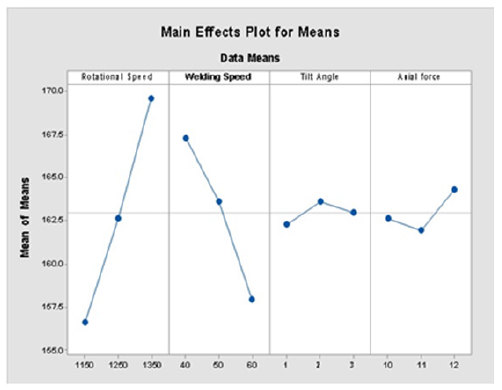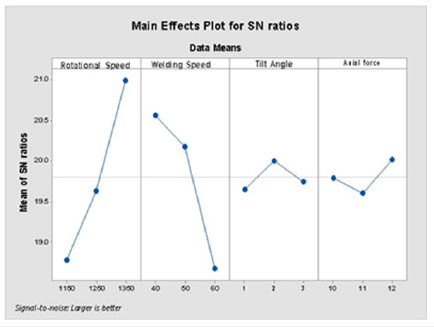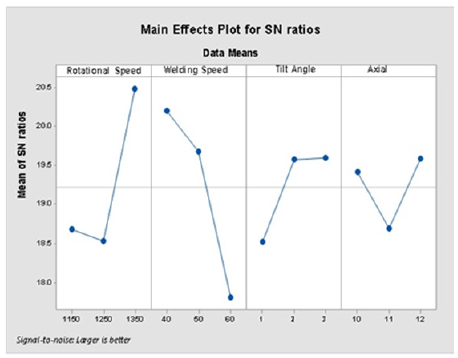- Submissions

Full Text
COJ Robotics & Artificial Intelligence
Investigations on Mechanical Properties for Aerospace and Defense Applications
Shaik B*1, Siddik Ali P2 and Muralidhara Rao R1
1Professor, Mechanical Engineering, Ramachandra College of engineering, India
1Assistant Professor, Mechanical Engineering, Ramachandra College of engineering, India
*Corresponding author: Shaik B, Professor, Mechanical Engineering, Ramachandra College of engineering, India
Submission: April 01, 2022;Published: May 23, 2022

ISSN:2832-4463 Volume2 Issue1
Abstract
Friction Stir Process complex process that involves many numbers of input process parameters to be controlled to get the best quality welds joints. Selecting the appropriate and optimal combination of input process parameters is the key to the success in the process. However, it is very difficult to identify and set the right combination manually by the process engineer either by using trial and error method or from the past references. Hence there is a need to develop a methodology that helps the manufacturing engineer or process engineer for proper setting of the input process parameter. This research mainly was carried out to develop the method which helps to run the process in an efficient manner and also the process can be automated help full for the Aerospace and Defense applications.
Keywords:Alloys paradigm; Environment friendliness; Aerospace and defense applications
Introduction
The joining of 2024 aluminum alloy with novel method for the keyhole of welds on friction stir spot welding of protrusion of anvil height [1] of tool rotational speed with variables are affected and increasing of nugget zone and joint length rotational speed 1600rpm and protrusion height 0.4mm and fine grains average size of 5μm at nugget zone with high [2]. Welding speed, penetration shoulder, pin profile, profile shoulder is optimized and maximize tensile strength with rotational speed 1100rpm and hexagonal pin profile welding speed 3.2mm/s 0.15mm shoulder penetration good and shoulder taper 10º and metallographic investigated of weld nugget zone fine stirred with magnesium silicide particles [3]. Mainly focusses on applications different parameters of tool rotational speed, weld speed, tilt angle and tool geometry with plunge speed on joining of softer structural alloys and aluminum alloys emerging technologies of lesser emphasis of different materials plasticization and generation of heat and quality of product on metals of lightweight fabrication. Studied of dissimilar joining of titanium or aluminum with concave end face tool and head enlarged are [4] designed to width of lap at flow of material and load of tensile is 12.2KN with 85.3% on aluminum alloy of heat affected zone effect due to ductile fracture with aluminum base metal. Investigated of brass plates 6mm thickness of process parameters rotational speed 450 and 710rpm. The rotational speed has higher and cracks taken place with a [5] smooth weld zone of free defect and size of grain at parent metal stirring zone are thermo mechanical effect zone and heat affect zone taken place in microstructural analysis and weld zone has higher hardness with recrystallized fine zones. Studied AZ31B Mg and AA6061 has advantages in [6] fuel consumption and transportation sectors, weight, and emission reduction. The stir zone has poor corrosion resistance and analyzed surfaces and microstructural techniques. The aluminum alloys and magnesium surfaces of PH are equal to 7 of Mg (OH)2 alloy on corroding with an increase of concentration chloride enhances of corrosion decreases with the increase of exposure time [7]. Studied simulations numerical on the reduction of time by using thermal analysis on rotational speed 2000rpm and weld speed is 10mm/min with a tensile test of joints weld on stress fracture validation is done. The joining of AA6061T4alloy and AZ31B increase in process temperature is 145 ºC of TMAZ and nugget zone of weld boundary decreased by [8] ultrasonic vibrations and tensile strength is improved low rotational speed but less noticeable higher rotational speeds. The welding of two similar polymer composites at configuration compares with two dissimilar thermoplastic materials that have similar viscosity [9] good chances. The input parameters of tool pin, tool shoulder, rotational speed, welding speed, tilt angle with a plunge have optimum heat generation of material flow time and resource energy have a minimum loss. Studied of FSW of Incoloy 800H on tensile strength, burn of length, micro- hardness, optimizing by using artificial neural network and algorithms for good predicted of parameters [10] with friction stir welding. Joining of A7N01-T4 alloy of methods on different joints shows free defect and comparisons of mechanical properties and microstructure on stir zone of grains.
Experimental Work
The studies were conducted out on a computer numerically controlled dissimilar alloys with artificially aged owing to bending tension released and heat treated solution aluminium alloys of 6mm thickness each. Friction Stir Welding is a special purpose machine that uses three different tools after conducting a literature survey and conducting in-depth investigations. The tools utilized include a square tool, a taper threaded tool, and a straight cylindrical threaded tool made of M2 grade ultra-high-speed steel with a shoulder dia of 18mm and a probe length of 6mm. The plates are finished with dimensions paired. On this basis, the specimens are prepared for testing with American society of testing materials standards [11,12].
Results and Discussions
The experimental planning of input process parameters speed of rotation (rpm), speed of welding (mm/min), angle of tilt (degree), longitudinal force (KN) and output parameters are elongation strength (Mpa), Impact strength (J), Tensile (%) with three different tools of the square tool, taper threaded tool, straight cylindrical threaded tool of coded values of input process parameters and Taguchi design models. The grey Taguchi analysis of friction stir welding by using taper threaded tool model design for input and output responses, S/N ratios and Means, Different Responses on Average values of Responses and Signal-to-noise-ratios.
Optimal level of factors for taper threaded tool
In the case of the Tapered threaded tool, the typical gray relational grade at each level of the factors was computed. The better the quality features, the greater the grey relation grade. Based on the higher grey relation grade, the ideal level of each adjustable component was decided. Table 1 shows the mean grey correlation grade and also the optimal component quantities. A1-B2-C1-D2 had the highest values of factor basis on grey relation grade. The effect of tensile strength gets using of taper threaded tool is seen in Figure 1. A greater obviously corresponds to higher quality characteristics. As a result, the optimum process parameter configuration has the highest. Analyzed using statistical software, and it indicated that the tensile strength was maximum 1350 revolutions per minute rotating rate, speed of welding 40mm/min, tilt angle of 30, and axial force of 11kN Table 2 displays which corresponds to the total average of quality attributes in the evaluation tables for tapered threaded tool. The effect of tensile strength for means of taper threaded tool is shown in Figure 2. Analysis for each trial will yield the best combination of parameters levels rotating speed 1250rpm, welding speed 50mm/min, tilt angle 20, axial force 11KN that assures a high level of responsiveness, Table 3 shows the response table for ‘means of tensile strength for the taper threaded tool.
Table 1:Optimal level of factors for taper threaded tool.

Figure 1:Tensile strength has an effect with taper threaded tool.

Table 2:Response table of S/N ratios of tensile strength for taper threaded tool.

Figure 2:Effect of tensile strength for means of taper threaded tool.

Table 3:Response table of tensile strength means for taper threaded tool.

Figure 3 depicts the ‘impact strength of a taper threaded tool’. For the computation of GRG average value, the process parameters of each level are considered, axial force 12KN are superior characteristics performance of S/N ratios and mean. The impact strength is approximately the same for all specimens and is low for the joint formed with a taper threaded tool, notwithstanding the influence of rotating speed (Table 4). The Effect of impact strength for means of taper threaded tool is shown in Figure 4. “The mean analysis for each experiment will yield a better mix of parameter values that assures a high degree of responsiveness based on the experimental data set. Quality features at each level Table 5 shows the response table for means of impact strength for taper threaded tool tables”. Maximum rotating speed 1350rpm, welding speed 40mm/min, tilt angle 20, and axial force 12KN were determined.
Figure 3:Effect of impact strength for taper threaded tool.

Table 4:Response table of impact strength for taper threaded tool.

Figure 4:Effect of impact strength for taper threaded tool.

Table 5:Response table of means of impact strength for taper threaded tool.

Figure 5 “depicts the effect of elongation on the signal-to-noise ratio of a taper threaded tool. For the computation of GRG average value, the process parameters of each level are considered rotating Table 6 shows the response table for S/N ratios of elongation for taper threaded tools”. The effect of elongation for means of taper threaded tool is shown in Figure 6. “The mean analysis for each experiment will yield a better mix of parameter values that assures a high degree of responsiveness based on the experimental data set.
Figure 5:The effect of elongation on a taper threaded tool’s signal-to-noise ratio.

Table 6:Response table of S/N ratios of elongation for taper threaded tool.g

Figure 6:Response table of S/N ratios of elongation for taper threaded tool.

Literature Review
This paper concludes Based on the pilot experiments and literature survey, the most significant variables are used them as input process parameters. Taguchi L9 Orthogonal Array was used to carry out the experiments. Because three different tool profiles i.e. taper threaded tools used for research. Application of Taguchi Design of Experiments helped us in conducting the experiments in an effective manner without losing accuracy. Two-dimensional plots are plotted parameters are taken analyze and validate using Design-Expert software. It was observed that the tensile strength is increasing with the increase in rotational speed and the xial force values and the tensile strength is decreasing with the increase in the weld speeds. “The Impact strength increases, when there is an increase values of variables, Whereas the impact strength tends to low with higher in weld speeds. Elongation also increases with the increase in rotational speed and axial force”. The models can be further used for optimizing the process.
References
- Dourandish S, Mousavizade SM, Ezatpour HR, Ebrahimi GR (2017) Microstructure, mechanical properties and failure behavior of protrusion friction stir spot welded 2024 aluminium alloy sheets. Science and Technology of Welding and Joining 23(4): 295-307.
- Gopi S, Manonmani K (2012) Study of friction stir welding parameters in conventional milling machine for 6082-T6 aluminum alloy. Australian Journal of Mechanical Engineering 10(2): 129-140.
- Padhy GK, Wu CS, Gao S (2018) Friction stir based welding and processing technologies - processes, parameters, microstructures, and applications: A review. Journal of Materials Science & Technology 34(1): 1-38.
- Huang Y, Lv Z, Wan L, Shen J, Dos Santos JF (2017) A new method of hybrid friction stir welding assisted by friction surfacing for joining dissimilar Ti/Al alloy. Materials Letters 207: 172-175.
- Rajesh G, Srimuthunath I, Santa Kumar N, Sugandipriya S, Aravindhan V (2018) Characterization of microstructure and hardness of friction stir welded brass plate. Materials Today: Proceedings 5(1): 2721-2725.
- Kamal Jayaraj R, Malarvizhi S, Balasubramanian V (2017) Electrochemical corrosion behavior of stir zone of friction stir welded dissimilar joints of AA6061 aluminum-AZ31B magnesium alloys. Trans Nonferrous Met Soc China 27(10): 2181-2192.
- Abhinand (2017) Numerical simulation of friction stir welding for dissimilar metal welding. Materials Today: Proceedings 4 (10): 11265-11269.
- Xueqi Lv, Song Wu C, Yang C, Padhy GK (2018) Weld microstructure and mechanical properties in ultrasonic enhanced friction stir welding of Al alloy to Mg alloy. Journal of Materials Processing Tech 254: 145-157.
- Kumar R, Singh R, Ahuja IPS, Penna R, Feo L (2018) Weldability of thermoplastic materials for friction stir welding- A state of the art review and future applications. Composites Part B: Engineering 137: 1-15.
- Annand, Kumar Barik B, Tamilmannan K, Sathiya P (2015) Artificial neural network modeling studies to predict the friction welding process parameters of Incoloy 800H joints. Engineering Science and Technology, an International Journal 18(3): 394-407.
- Shaik B, Gowd H, Durga Prasad B, Siddik P (2022) Investigations on microstructures by using friction stir processing. Intelligent Manufacturing and Energy Sustainability, Smart Innovation, Systems and Technologies, pp. 539-548.
- Shaik B, Harinath Gowd G, Durga Prasad B (2019) Parametric investigations on friction stir welding of aluminium alloys. Emerging Trends in Mechanical Engineering, Lecture Notes in Mechanical Engineering, pp. 333-345.
© 2022 Shaik B. This is an open access article distributed under the terms of the Creative Commons Attribution License , which permits unrestricted use, distribution, and build upon your work non-commercially.
 a Creative Commons Attribution 4.0 International License. Based on a work at www.crimsonpublishers.com.
Best viewed in
a Creative Commons Attribution 4.0 International License. Based on a work at www.crimsonpublishers.com.
Best viewed in 







.jpg)






























 Editorial Board Registrations
Editorial Board Registrations Submit your Article
Submit your Article Refer a Friend
Refer a Friend Advertise With Us
Advertise With Us
.jpg)






.jpg)














.bmp)
.jpg)
.png)
.jpg)










.jpg)






.png)

.png)



.png)






